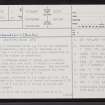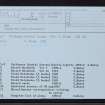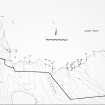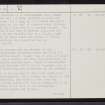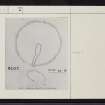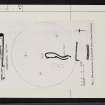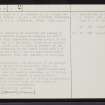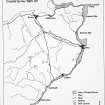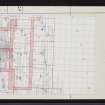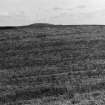Ham
Mound (Period Unassigned), Souterrain(S) (Prehistoric)
Site Name Ham
Classification Mound (Period Unassigned), Souterrain(S) (Prehistoric)
Alternative Name(s) Dun 009
Canmore ID 8883
Site Number ND27SW 1
NGR ND 2381 7385
Datum OSGB36 - NGR
Permalink http://canmore.org.uk/site/8883
- Council Highland
- Parish Dunnet
- Former Region Highland
- Former District Caithness
- Former County Caithness
ND27SW 1 2381 7385.
(ND 2381 7385) Chambered Mound (NR)
OS 1:10,000 map, (1976)
Ham: Reputedly a chambered cairn (Edwards 1925; Feachem 1963) but not accepted as such by Henshall (1963), this site is recorded as an earth-house by the RCAHMS (1911), but even after excavation by Edwards in 1924 its nature is uncertain.
It consists of a circular mound of stones and boulders, thinly covered with soil and turf, in which is a narrow chamber approached from the S by a passage. The perimeter of the mound is not definable but the diameter has been about 100ft and the height is 8 to 9ft.
The unpaved passage, destroyed at its outer end but still partially covered with lintels, is curved and measures 2ft in width, from 1ft 6ins to 3ft 10ins in height and about 20ft in length.
The chamber is 14ft 9ins long by 3ft 6ins to 4ft 10ins in width with oversailing drystone walls roofed by flags at a height of 6ft 6ins. Near the end of the W wall, 3ft above floor level is a small recess averaging 1ft 3ins in height, width and depth. Limpet shells and fish bones were found in this recess and also on the floor of the chamber where 'quern stones' and animal bones have also been found (ONB 1873).
On excavation an oval depression in front of the entrance proved to be flanked by opposing walls, 19ft apart, running E-W and both faced only on the S side. The N wall was straight, 26ft long and almost 4ft high. A right angled corner was formed by a possibly secondary stretch of walling, 4ft long, at its W end. This was faced only on its E side and its termination was rough and irregular giving the impression of having continued. The S wall was slightly curved, 23ft long and 3ft high.
Both long walls were topped by regularly laid slabs about 2ft 6ins in breadth. Behind this structure was the mass of stones and boulders which formed the body of the mound, of which the wall appeared to be an integral part.
This is probably the monument referred to by Bishop Pococke (1887) in the mid-18th century and by the OSA (1794) in the late 18th century as having two chambers with separate entrances.
A S Henshall 1963; RCAHMS 1911; A J H Edwards 1925; Statistical Account (OSA) 1794; R Pococke 1887; Name Book 1873; R W Feachem 1963.
This site now consists of a turf-covered stony mound, 21m in diameter and 3m high, covering a paved and corbelled chamber, 4.7m long by 1.7m broad and 1.8m high, with a hole in the roof of massive stone lintels. The passage on the S has been so greatly mutilated and robbed that it is now visible only as a slight, turf-covered hollow, in which there are traces of inside walling now surviving to a height of 0.4m.
Resurveyed at 1:2500.
Visited by OS (R D) 26 February 1965.
The chamber and passage are reminiscent of the subterranean structures on Orkney which the RCAHMS, describe as 'earth-houses', though few, if any, of these support a lintelled chamber-roof. Those at Rennibister (HY31SE 3) and Saverock (HY51SW 5), however, have a combination of corbelling and orthostats in the chamber.
The dimensions of the passage at this site agree with their Orkney counterparts, but although the length of the chamber is acceptable, the width is less than the generality of Orkney sites, but that at Gripps (HY42NW 27) is comparable, as is that of the passageless structure at South Keigar (ND50NE 9).
(Undated) information from OS.
Souterrains in mound 28m in diameter by 4.5m high; two passages.
a: Chamber 5 by 3m - as previously described.
b: Passage 8 by 1.5m. Collapsed. NW-SE.
R J Mercer 1981.
The remains are generally as described and planned by Mercer. The lintelled passage and chamber are still accessible but rough vegetation obscures details of the structures to the S of the mound. There is no positive evidence of a second cell as noted by Pococke (1887) and the OSA (1794), but a depression in the summit immediately W of the chamber and the line of the old excavation trench (marked A on Edwards' [1925] plan) may indicate its collapsed presence.
The mode of construction, size and shape of the passage and chamber is typical of a souterrain, though the passage is narrower than is usual. Edwards established by excavation that the mound is man-made, yet it is too large to have been built merely to accommodate a souterrain. The relationship of the walling immediately S of the mound (see Edwards' plan) to the mound and souterrrain is not now ascertainable.
Visited by OS (NKB) 21 May 1982.
Most authorities regard this as two souterrains under an artificial mound.
J L Davidson and A S Henshall 1991.
Project (1980 - 1982)


















